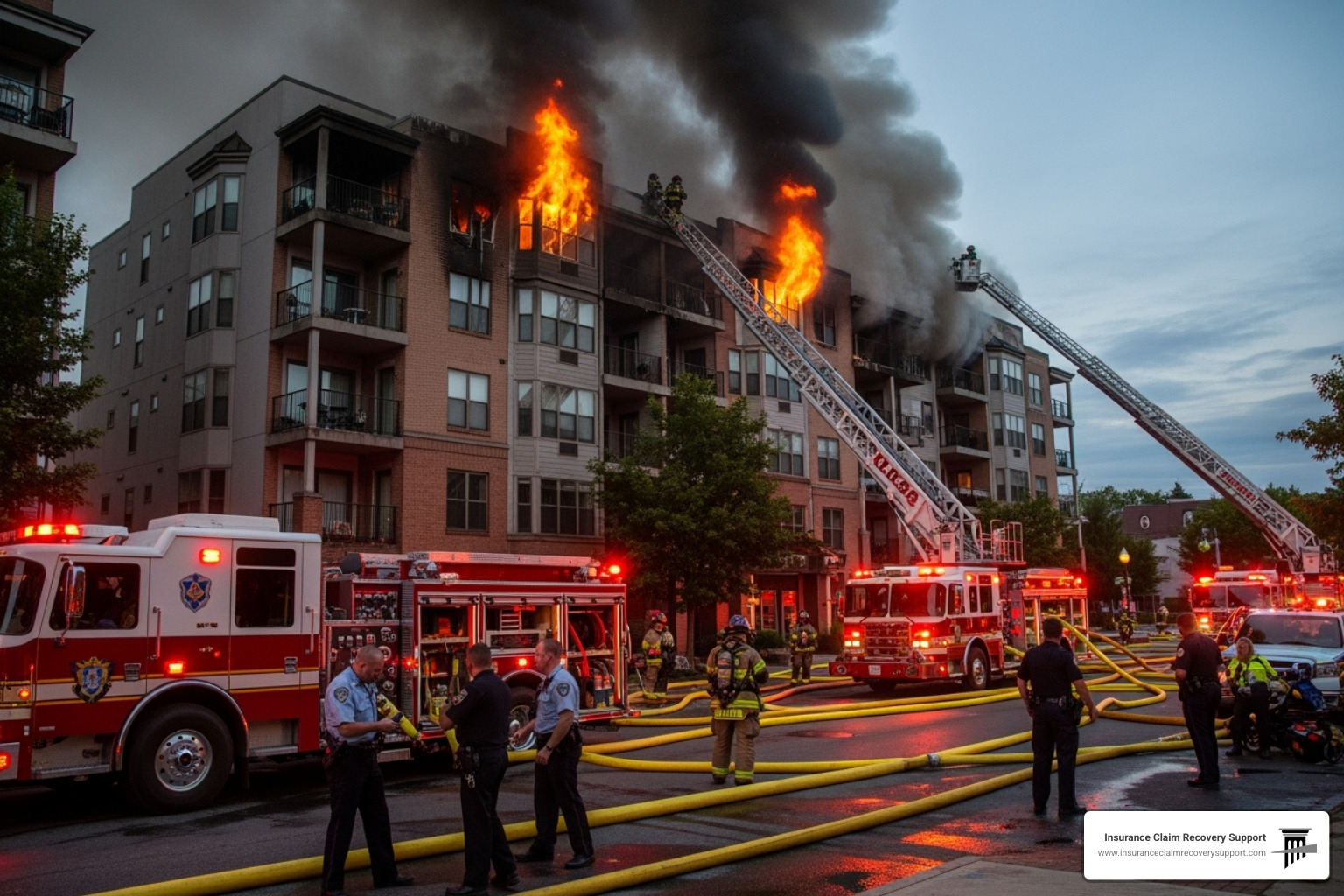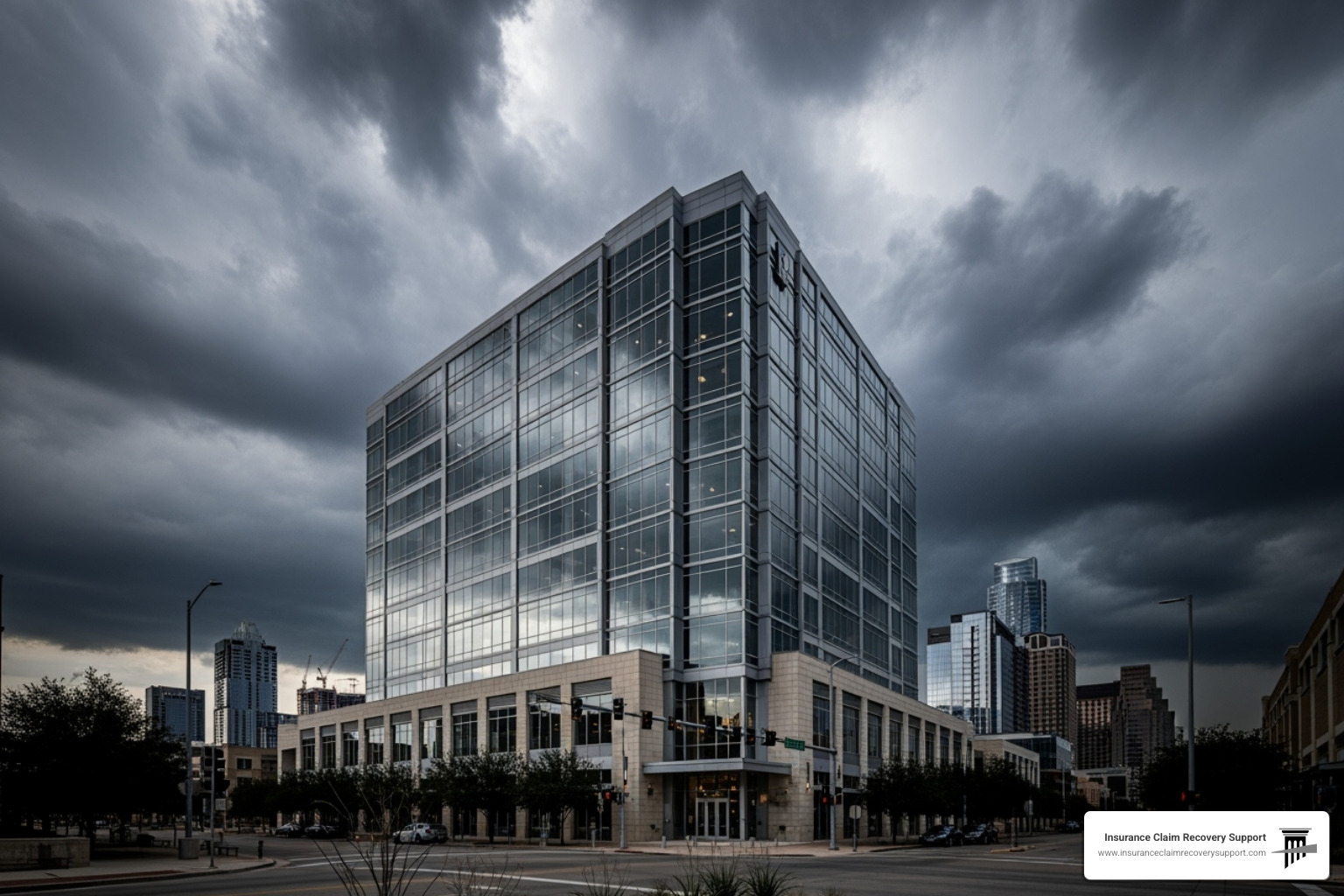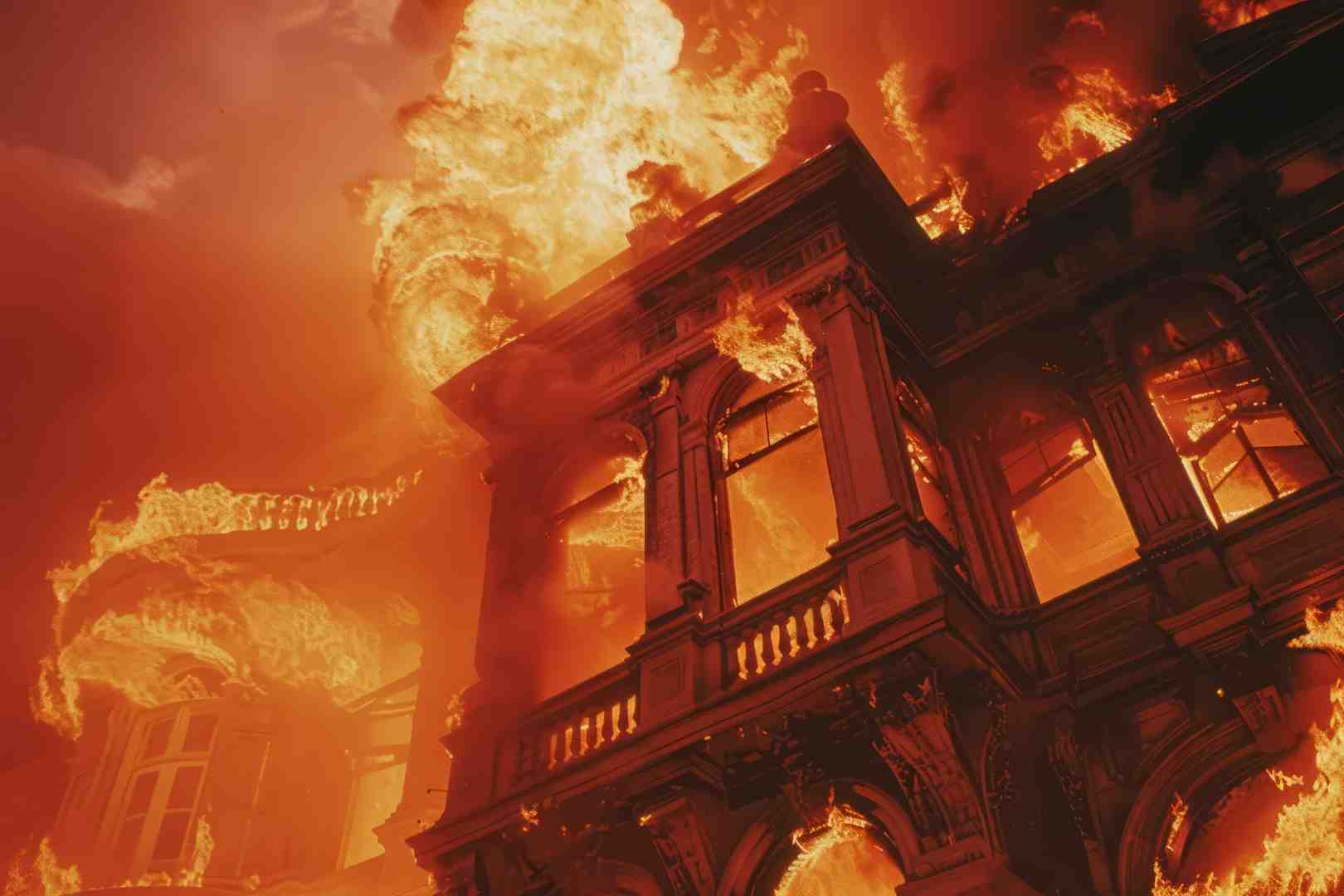Why Multifamily Fire Safety Matters More Than You Think
Multifamily fire incidents can devastate entire communities in minutes. On a cold January morning in 2022, a simple space heater malfunction in a Bronx apartment complex sparked flames that sent thick black smoke through all 19 floors, resulting in 17 deaths and 44 injuries. This tragic event highlights a critical reality: fires in multifamily buildings spread differently and pose unique challenges compared to single-family homes.
Key multifamily fire risks and facts:
- Fire spreads rapidly – In just 30 seconds, a minor fire can become life-threatening for all residents
- Smoke travels fast – Shared HVAC systems can spread toxic fumes throughout the building
- Common causes – Cooking accidents, electrical issues, heating equipment, and smoking materials
- Building factors – Shared spaces like stairwells and attics can accelerate fire spread
- Prevention works – Modern fire codes require sprinklers in buildings with 3+ units
- Recovery is complex – Multiple units, common areas, and displaced residents create challenging insurance claims; engaging a licensed public adjuster early helps align coverage, scope, and valuation to expedite a fair settlement and often avoid unnecessary litigation
The majority of existing fire research has focused on single-family homes, yet multifamily buildings house millions of Americans and present distinct safety challenges. Shared walls, common stairwells, and connected utility systems all impact how fires start, spread, and affect residents.
As Scott Friedson, a multi-state licensed public adjuster and CEO of Insurance Claim Recovery Support, I’ve helped commercial and multifamily property owners and managers steer hundreds of millions in fire damage claims across Texas and nationwide. Through settling 500+ large loss multifamily fire claims, I’ve seen how involving a public adjuster early— to document damage, coordinate experts, and negotiate with carriers on the policyholder’s behalf—can resolve disputes efficiently and keep claims out of court when possible.

Simple guide to mulitfamily fire terms:
Understanding the Risk: Common Causes and Prevention Strategies
When it comes to multifamily fire safety, knowledge truly is power. Most fires aren’t random acts of nature – they’re preventable incidents with surprisingly predictable causes. Understanding these patterns gives property owners and managers a real advantage in protecting their investments and their tenants.
Here’s what makes this especially important: research shows that the items first ignited in residential fires are typically contents and furnishings within individual units. This means your residents’ daily habits and your management practices work hand-in-hand to determine your property’s fire risk.
Primary Causes of Multifamily Fires
The statistics tell a clear story about where multifamily fire incidents typically begin:
Cooking accidents top the list every year. Unattended pots, grease fires, and kitchen equipment mishaps can transform a room into a furnace reaching over 300 degrees Celsius in minutes. At those temperatures, toxic smoke and soot get forcefully driven into walls, insulation, and furniture throughout the building.
Heating equipment poses another major threat. Space heaters, furnaces, and other heating devices become dangerous when placed too close to combustible materials or when poorly maintained. Remember the tragic Bronx fire we mentioned earlier? It started with a simple space heater malfunction.
Electrical malfunctions cause significant damage, especially in older buildings with outdated wiring systems. Overloaded circuits, faulty outlets, and misused extension cords create perfect conditions for electrical fires to spark.
Smoking materials remain a persistent cause of residential fires. Improperly discarded cigarettes or smoking in bed can ignite bedding, furniture, or other materials hours after residents think the danger has passed.
Grill fires deserve special attention in multifamily settings. Here’s a startling fact: 24% of residential grill fires start on balconies and unenclosed porches. Many fire codes now prohibit grilling on apartment balconies or within 10 feet of any structure for good reason.
Arson, while less common, represents a serious threat that requires vigilance and proper security measures.
Contributing Factors to Fire Risk
Beyond immediate ignition sources, several factors can turn a small incident into a major catastrophe:
Building age plays a crucial role in fire safety. Older properties often have electrical systems that weren’t designed for modern appliance loads, less effective firestopping materials, and construction that predates current safety codes.
Poor maintenance allows small problems to become big hazards. Neglected electrical systems, clogged dryer vents, and unmaintained HVAC units create conditions where fires can start and spread rapidly.
Overcrowding multiplies risks in several ways. More residents mean more potential ignition sources, increased clutter that can fuel fires, and more complex evacuation challenges during emergencies.
Flammable contents significantly influence how fires develop. The furniture, decorations, and personal belongings residents bring into their units can determine whether a small fire stays contained or spreads throughout the building.

Prevention Strategies for Property Managers
As a property owner or manager, you’re positioned to make the biggest difference in multifamily fire prevention. Your proactive approach protects both your investment and your residents’ lives.
Resident education forms the foundation of fire safety. Regular communication about safe cooking practices, proper heating device usage, electrical safety, and smoking restrictions helps residents understand their role in prevention. Share escape plan information and encourage families to practice their routes.
Regular inspections help you catch problems before they become disasters. Look for overloaded outlets, blocked exit paths, improperly stored flammable materials, and other hazards during routine unit visits and common area walkthroughs.
Enforcing community rules consistently sends a clear message about safety priorities. This includes strict enforcement of grilling restrictions, smoking policies, and appliance usage guidelines. Don’t let small violations slide – they often lead to bigger problems.
Maintaining building systems requires ongoing attention to electrical systems, HVAC equipment, and fire safety devices. Dryer vent cleaning deserves special emphasis, as lint buildup creates serious fire hazards that many property managers overlook.
Fire Prevention Checklist for Property Managers
- Develop and distribute comprehensive fire safety guidelines to all residents
- Inspect and maintain fire alarms, smoke detectors, and sprinkler systems regularly
- Keep clear access to all fire exits, stairwells, and common areas
- Conduct annual fire drills and communicate updated evacuation plans
- Clean dryer vents in laundry rooms and individual units on schedule
- Enforce grilling restrictions on balconies and near building structures
- Provide designated smoking areas away from buildings and combustible materials
- Inspect electrical systems and common area appliances routinely
- Maintain fire extinguishers in proper working condition and accessible locations
- Partner with local fire departments for professional safety audits and guidance
Claims-readiness for owners and managers
- Keep dated photos/videos of roofs, units, and common areas to document pre-loss conditions
- Centralize maintenance logs, vendor invoices, and inspection reports
- Retain permits and code-compliance documents for building systems and recent upgrades
- Use incident reports for all fire-related events (even small ones) with time-stamped details
- Maintain updated unit rosters, leases, and business interruption records (lost rents, relocation costs)
These records help a public adjuster build a defensible scope of loss, accelerate fair payment, and reduce the chance you’ll need to litigate the claim.
The Blueprint for Safety: How Building Design and Codes Mitigate Fire Spread
When it comes to multifamily fire safety, the building itself is your first line of defense. Unlike single-family homes where a fire might stay contained to one structure, multifamily buildings present unique challenges. One unit’s kitchen fire can quickly become everyone’s nightmare if the building wasn’t designed with proper safety measures.
The good news? Modern building codes have learned from past tragedies, creating comprehensive safety standards that dramatically reduce fire spread and save lives.
Fire Codes and Building Regulations
Today’s multifamily buildings aren’t built by guesswork—they follow strict fire safety standards that have evolved over decades of research and real-world experience.
The NFPA (National Fire Protection Association) sets the gold standard with codes like NFPA 101 Life Safety Code, which focuses on protecting occupants during emergencies. Meanwhile, the International Building Code (IBC) establishes minimum requirements for everything from structural strength to fire resistance and emergency exits.
Here in Texas, cities like Austin, Dallas, Houston, Fort Worth, San Antonio, Lubbock, and San Angelo, as well as communities like Waco, Round Rock, Georgetown, and Lakeway, adopt these national standards while sometimes adding their own local requirements. Texas has particularly strict codes for connected townhouses, recognizing how quickly fire can jump between units. Generally speaking, fire codes for multifamily buildings are much tighter than for single-family homes, substantially reducing risk for everyone involved.
Compartmentation: The Art of Containment
Think of compartmentation as creating invisible boxes within your building. The goal is simple: keep a fire trapped in its room or unit of origin, giving everyone else time to evacuate safely.
Firewalls are the workhorses of this system. These specially constructed walls extend from the foundation through the roof, creating physical barriers between units or building sections. They’re designed to resist fire for specific periods—typically one to two hours—buying precious time for evacuation and firefighting efforts.
But walls are only as strong as their weakest point. That’s why fire-rated doors and windows must meet the same resistance standards. Any opening for pipes, wires, or ducts gets properly sealed with firestopping materials to prevent fire and smoke from sneaking around these barriers.
Shared Spaces: Unique Challenges
While compartmentation works well for individual units, shared spaces in multifamily buildings present special challenges that require careful attention.
Common cocklofts or attics can become superhighways for fire and smoke. These large, undivided spaces above units allow flames to spread rapidly across multiple apartments or even entire buildings. The devastating Edgewater, New Jersey fire that displaced thousands of residents demonstrated this risk dramatically. Modern codes now require fire-blocking within these spaces to slow this spread.
Shared stairwells create a double-edged situation. While they’re essential for evacuation, they can also become conduits for deadly smoke if not properly managed. That’s why smoke control systems are so critical in these areas.
Perhaps most concerning, HVAC systems can spread smoke throughout the building, carrying toxic fumes and gases to units far from the original fire. This interconnected nature of multifamily buildings means that proper smoke control systems aren’t just nice-to-have features—they’re essential for life safety.
Active vs. Passive Fire Protection
Fire safety systems fall into two main categories, and the best buildings use both effectively:
Active Fire Protection includes systems that “do something” when a fire occurs. Sprinkler systems automatically activate to suppress flames, fire alarms alert occupants and emergency services, and smoke control systems manage air flow to keep escape routes clear. These systems require power, maintenance, and regular testing to function properly.
Passive Fire Protection, on the other hand, works without any activation. Firewalls and fire-rated doors provide barriers, fire-rated glass maintains visibility while resisting heat, and firestopping materials seal penetrations. These systems are always “on duty” and don’t rely on electricity or mechanical operation.
The most effective multifamily buildings combine both approaches, creating multiple layers of protection that work together during an emergency.
Building Height Differences
Not all multifamily buildings face the same requirements. Low-rise buildings (typically three stories or less) have different safety standards than high-rise structures. As buildings get taller, codes become more stringent.
Sprinkler mandates vary by height and local codes, but many areas now require automatic sprinkler systems in buildings with three or more units. High-rise buildings face additional requirements for smoke control systems, pressurized stairwells, and improved communication systems.
Key Safety Equipment
Every multifamily building should have essential safety equipment properly installed and maintained. Smoke alarms provide early warning, sprinkler systems can suppress fires before they spread, and fire extinguishers give residents a fighting chance against small fires.
The key isn’t just having this equipment—it’s ensuring everything works when needed. Regular inspections, testing, and maintenance make the difference between a minor incident and a major multifamily fire disaster.
When fire does strike despite all precautions, proper building design and safety systems can mean the difference between a manageable insurance claim and a catastrophic loss. Understanding these systems helps commercial and multifamily property owners and managers make informed decisions about their buildings and insurance coverage.
Public adjuster vs. insurance lawsuit: what owners should know
For commercial and multifamily owners, there are two common paths when a property damage claim becomes contentious:
Public Adjuster (PA)
- Typical timeline: weeks to a few months for negotiated resolutions; faster cash flow to begin mitigation and repairs
- Cost structure: contingent fee on recovery; generally no court costs or lengthy discovery
- Process: comprehensive coverage review, detailed scope/pricing, business interruption calculations, Proof of Loss submission, and direct negotiations with the carrier while you retain control of decisions
- Outcome: prioritized settlement without court; escalation options include appraisal or mediation if needed—often avoiding unnecessary litigation altogether
Insurance Lawsuit
- Typical timeline: 12–24+ months due to pleadings, discovery, expert depositions, and potential trial/appeals
- Cost structure: attorney fees, expert costs, and court expenses; net recovery and timelines can be uncertain
- Process: formal, adversarial, and time-intensive; business disruption and delayed restoration funding are common
- Outcome: uncertain judgment; potential for appeals and prolonged resolution
Practical takeaway: Engage a licensed public adjuster early to develop a defensible claim file and negotiate from a position of strength. If counsel becomes necessary, a PA-prepared record (scope, pricing, documentation, and valuation) can shorten litigation and improve outcomes. Consult qualified legal counsel for legal strategy decisions.
For more information about fire damage claims, visit our Fire Damage Claim Help page.





